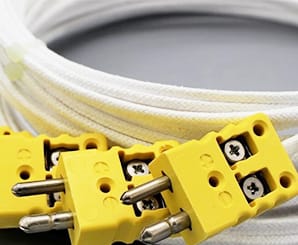When it comes to measuring temperature in extreme conditions, a high temp thermocouple is often the best choice across many industries. These sensors endure high heat and provide accurate readings, making them essential in various applications. However, choosing the right high temperature thermocouple can be challenging. This guide helps you understand high temp thermocouples, covering their types, specifications, applications, and maintenance, while addressing common misconceptions to improve your selection process.
Understanding High Temp Thermocouples: An Overview
High temp thermocouples are temperature sensors made from two different metal wires joined at one end. When the junction of these wires encounters heat, it generates a voltage that can be measured and linked to temperature. This effect is known as the Seebeck effect.
How High Temp Thermocouples Work
High temp thermocouples operate on the principle that different metals generate varying voltages when exposed to temperature changes. The voltage produced is proportional to the temperature difference between the measurement junction (hot junction) and the reference junction (cold junction). This relationship allows for precise temperature readings, even in tough environments.
Importance in Industrial Applications
In industries like aerospace, automotive, and manufacturing, high temp thermocouples play a crucial role in monitoring processes that operate at elevated temperatures. They help ensure systems stay within safe operating ranges and help prevent equipment failures. For example, during engine testing in the aerospace sector, accurate temperature readings are vital for safety and performance.

Types of High Temp Thermocouples: Which One is Right for You?
High temp thermocouples come in various types, each suited for specific applications and temperature ranges. The most common types are:
Type K Thermocouples
Type K thermocouples, made from chromel and alumel, are popular for their wide temperature range of -200°C to 1260°C (-328°F to 2300°F). They are durable and resistant to oxidation, making them ideal for applications like furnaces and kilns.
Type S Thermocouples
Type S thermocouples, made from platinum and rhodium, handle high temperatures up to 1480°C (2700°F). They are commonly used in laboratories and industries needing high precision due to their stability and accuracy.
Type R and Type B Thermocouples
Type R and Type B thermocouples are similar to Type S but can withstand even higher temperatures. Type R operates at up to 1600°C (2912°F), while Type B can handle up to 1700°C (3092°F). These thermocouples are mainly used in metal processing and glass manufacturing.
Selecting the Right Type
When choosing a thermocouple type, consider the specific temperature range and environmental conditions of your application. For example, if you’re in a high-oxidizing atmosphere, Type K might be more suitable due to its corrosion resistance.
Key Specifications to Consider When Selecting a High Temp Thermocouple
Several key specifications should guide your decision when selecting a high temp thermocouple:
Temperature Range
The temperature range is the most critical specification. Ensure the thermocouple can handle the maximum temperatures expected in your application.
Accuracy and Sensitivity
Accuracy indicates how close the thermocouple’s readings are to the actual temperature. Sensitivity shows how quickly the thermocouple responds to temperature changes. Higher sensitivity equals faster response times, crucial in dynamic applications.
Response Time
Response time measures how long it takes for the thermocouple to reach a stable reading after a temperature change. Fast response times are vital in processes involving rapid temperature fluctuations.
Wire Material and Insulation
The wire material affects the thermocouple’s durability and performance. Insulation materials impact the thermocouple’s ability to withstand high temperatures and corrosive environments.
Junction Type
The junction type—grounded, ungrounded, or exposed—affects the thermocouple’s response time and accuracy. Grounded junctions provide faster response times, while ungrounded junctions offer better electrical insulation.
Applications of High Temp Thermocouples in Various Industries
High temp thermocouples find use across many industries, each with specific applications:
Aerospace Industry
In aerospace, high temp thermocouples monitor engine temperatures during flight tests. Accurate readings are crucial for ensuring safety and performance. For example, thermocouples are used to gauge the temperatures of turbine blades, which can reach extreme levels during operation.
Automotive Testing
Automakers use high temperature thermocouples in engine testing to monitor combustion chamber temperatures. This data helps engineers optimize engine performance and efficiency.
Manufacturing Processes
In manufacturing, these thermocouples monitor temperatures in processes like welding, forging, and heat treatment. Proper temperature control is essential for product quality and safety.
Research and Development
In laboratories, high temperature thermocouples measure precise temperatures in experiments, such as material testing and chemical reactions.
Material Choices: How They Affect Performance and Durability
The materials in high temp thermocouples significantly impact their performance and durability:
Metal Composition
The two metals used in a thermocouple determine its temperature range, sensitivity, and stability. For example, platinum-based thermocouples, like Type S, offer excellent stability but cost more.
Insulation Materials
Insulation materials, such as ceramic or fiberglass, protect the thermocouple wires from high temperatures and corrosive environments. Choosing the right insulation material is essential for extending the thermocouple’s lifespan.
Protective Sheaths
In harsh environments, protective sheaths made from materials like Inconel or stainless steel enhance durability and prevent damage to the thermocouple.
Installation Tips for Optimal Performance of High Temp Thermocouples
Proper installation is vital for the accurate functioning of high temp thermocouples. Here are some tips to ensure optimal performance:
Positioning the Thermocouple
Position the thermocouple correctly to measure the intended temperature. Place it in an area with good airflow, away from heat sources that could skew readings.
Securing the Thermocouple
Secure the thermocouple to prevent movement during operation. Loose thermocouples can lead to inaccurate readings and damage over time.
Calibration
Always calibrate the thermocouple before use. Regular calibration ensures readings remain accurate and reliable throughout its lifespan.
Environmental Considerations
Consider the environmental conditions where the thermocouple will be installed. Factors such as exposure to chemicals, moisture, or mechanical stress can affect performance.
Common Mistakes to Avoid When Choosing a High Temp Thermocouple
Avoid these common mistakes when selecting a high temp thermocouple:
Ignoring Temperature Ratings
Choosing a thermocouple without considering its temperature rating can lead to failures and inaccurate readings. Always ensure the thermocouple’s rating exceeds your application’s maximum temperature.
Overlooking Calibration Needs
Neglecting to calibrate your thermocouple can result in measurement errors. Regular calibration is crucial for maintaining accuracy over time.
Choosing the Wrong Type
Not all thermocouples are created equal. Select a type that matches your specific application requirements, including temperature range, environment, and sensitivity.
Neglecting Installation Guidelines
Improper installation can lead to inaccurate readings and early failure. Follow manufacturer guidelines for optimal placement and securing of the thermocouple.
Misconceptions about Thermocouple Use
One common misconception is that all thermocouples can be used interchangeably. This is not true, as different thermocouples have specific properties that make them suitable for different applications.
Calibration and Maintenance: Ensuring Accuracy Over Time
Regular calibration and maintenance are essential for high temp thermocouples:
How to Calibrate a Thermocouple
Calibration involves comparing the thermocouple’s readings against a known standard. This process can use calibration baths or reference thermometers. Perform regular calibration at intervals recommended by the manufacturer or based on operational conditions.
Routine Maintenance Practices
Routine maintenance includes checking for wear or damage, ensuring connections are secure, and cleaning contaminants from the thermocouple’s surface. Regular inspection helps identify potential issues before they affect performance.
Importance of Documentation
Keep records of calibration and maintenance activities. Documentation tracks performance over time and ensures compliance with industry standards.
Cost vs. Quality: Finding the Best Value in High Temp Thermocouples
Balancing cost and quality is crucial when investing in high temp thermocouples:
Understanding Pricing Factors
The price of high temperature thermocouples varies based on type, material, and manufacturer. While it might be tempting to choose the cheapest option, consider long-term costs associated with lower quality, including maintenance and replacement.
Evaluating Quality
Look for thermocouples from reputable manufacturers that offer warranties and have a history of reliability. Investing in quality products can save money in the long run by reducing failure rates and maintenance needs.
Considering Total Cost of Ownership
Evaluate the total cost of ownership, which includes purchase price, installation, maintenance, and potential downtime costs. A higher initial investment in quality thermocouples may result in lower overall costs.
Future Trends in Temperature Sensing Technology
As technology advances, the future of temperature sensing, including high temp thermocouples, looks promising:
Advances in Materials
Research is ongoing to develop new materials that can withstand even higher temperatures while providing improved accuracy and sensitivity.
Integration with IoT
Integrating thermocouples with the Internet of Things (IoT) allows for real-time monitoring and data analysis, enhancing efficiency and predictive maintenance.
Enhanced Calibration Techniques
Future advancements may lead to more automated and precise calibration techniques, improving the reliability of temperature measurements across industries.
Miniaturization of Sensors
The trend towards smaller, more compact sensors continues, allowing for greater flexibility in applications where space is limited.
| Section | Key Points | Considerations | Examples of Applications |
| Understanding High Temp Thermocouples | – Made from two different metals.
– Operate on the Seebeck effect. |
– Choose based on application needs. | – Engine testing in aerospace. |
| Types of High Temp Thermocouples | – Type K: -200°C to 1260°C, durable.
– Type S: Up to 1480°C, high precision. |
– Match thermocouple type with temperature range. | – Laboratory experiments. |
| Key Specifications | – Temperature range, accuracy, sensitivity, response time, wire material, insulation, junction type. | – Assess for specific application needs. | – Welding and forging processes. |
| Applications of High Temp Thermocouples | – Aerospace, automotive testing, manufacturing, research. | – Consider industry-specific requirements. | – Monitoring combustion chamber temperatures. |
| Material Choices | – Metal composition, insulation materials, protective sheaths. | – Select materials based on durability and performance needs. | – Protective sheaths in harsh environments. |
| Installation Tips | – Proper positioning, securing, calibration, and environmental considerations. | – Follow best practices for installation. | – Thermocouple installation in kilns. |
| Common Mistakes | – Ignoring ratings, calibration needs, wrong type selection, neglecting installation guidelines. | – Be aware of common pitfalls to avoid. | – Using inappropriate thermocouple types. |
| Calibration and Maintenance | – Regular calibration and routine maintenance.
– Importance of documentation. |
– Establish a maintenance schedule for longevity. | – Calibration before use in experiments. |
| Cost vs. Quality | – Understand pricing factors, evaluate quality, consider total cost of ownership. | – Balance short-term costs with long-term reliability. | – Investing in reputable brands. |
| Future Trends | – Advances in materials, IoT integration, enhanced calibration techniques, miniaturization. | – Stay informed about technological advancements. | – Real-time monitoring systems. |
Featured client/products:
Glass Floors | Semi Truck Ramp | Glass Blocks| SEO Services Near Me | Steel Yard Ramp | Ramp for Loading Dock | Glass Flooring | Loading Dock Ramps | Portable Yard Ramp | SEO Company Near Me | SEO Agency Akron | SEO Expert Near Me | Marketing Agencies Near Me | Marketing Agency Akron
Yard Ramps | Yard Ramp




